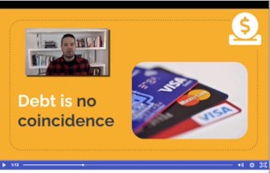Family Money School offers online courses about personal finances and money with options for either younger or older children. Young Money Adventures teaches parents how to teach their own children about money matters, providing practical applications that parents can use as they discuss money topics with their children ages 12 and younger. Money Genius Academy for ages 13 to 18 is presented directly to teens. You can have access to both courses through the Ultimate Family Money School membership. All memberships give you lifetime access.
The focus of this review is the Money Genius Academy for teens.
The course is presented in ten modules, and students should plan to spend about one week per module. In each module, there are three to nine videos that average about ten minutes in length. The videos feature Matt Matheson, a teacher and personal-finance writer. Sometimes the videos show him speaking, and other times they have his voiceover audio presentation with slides.
The videos are accompanied by printable pages for taking notes and for activities, except for the first session. Frequent activities have students apply what they have learned to real-life situations, sometimes recording information over time to come up with data to analyze.
Among the topics the course addresses are work, earning money, smart spending, debt, credit, saving, budgeting, banking, investing, giving, and social media. (I’ll explain later how social media fits in.) These are topics that should be of concern to most teens, although a few topics, like getting a bank account and investing, might not apply for a few years.
Matheson begins by addressing two major problems in our culture: the huge debt burden many people carry and the inclination toward instant gratification that can be a contributing cause of that debt. Matheson addresses both the challenges and the benefits of handling money, and he always brings the lessons back to very practical applications—usually with the follow-up activities for each topic.
For instance, in the module about debt he has an activity where students calculate the snowballing costs of credit card purchases that the buyer doesn’t plan to pay off immediately. Students figure out that the first purchase of a video game system is manageable, but purchasing new tires for their car on top of the prior charge stretches out the debt repayment even further. By the time students calculate a third credit card charge for an unexpected car repair, it becomes frighteningly obvious that the costs of the interest far outstrip the original charges for goods and services.
Some activities are very personal. In an activity titled “How Patient Are You?” students answer multiple-choice questions that help them objectively assess how willing they are to wait for the fulfillment of their wishes and needs. Other personal activities are the creation of their own resume and their own budget.
Matheson encourages students to save money by “paying themselves first.” Looking to the future, students learn how to open and manage a bank account, and they also learn about investing in the stock market by using a free online stock-market simulation to practice investing.
In the ninth module, Matheson encourages generosity by discussing possibilities under the headings of time, talent, and treasure.
The tenth module is a bit unusual. Here Matheson discusses the idea that students should learn to be grateful. Related to this, he talks about social media and how it affects young peoples’ attitudes. He focuses particularly on envy and negative feelings created by social media, especially as young people compare themselves to the often false images of others that have been crafted for social media. He relates this to money since people often buy things or spend money on experiences because of social pressure or because they mistakenly believe that these expenditures will bring them happiness. He challenges students to fast from social media for one week and, instead, focus on being grateful.
This is not a religiously oriented course, but Matheson quotes the Bible a few times and mentions that some students might donate to a church or participate in faith-related activities. Even so, the course is presented in a way that makes it useful for everyone, whether or not they are religious.
The course is very practical and easy for teens to work through on their own.









